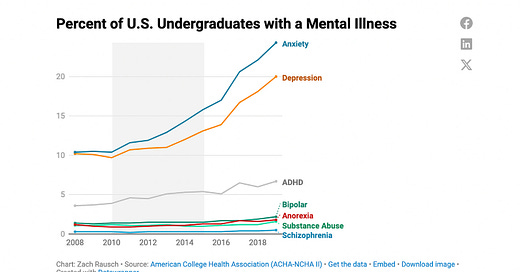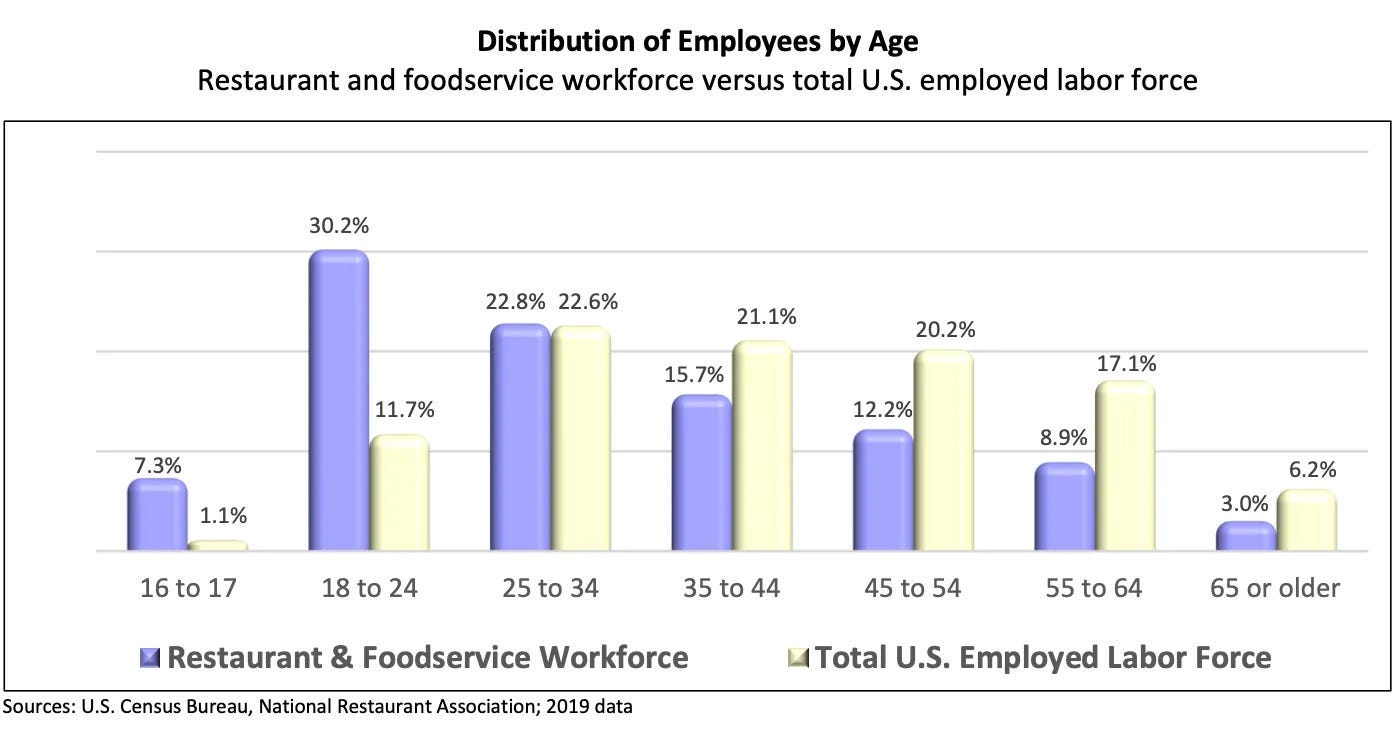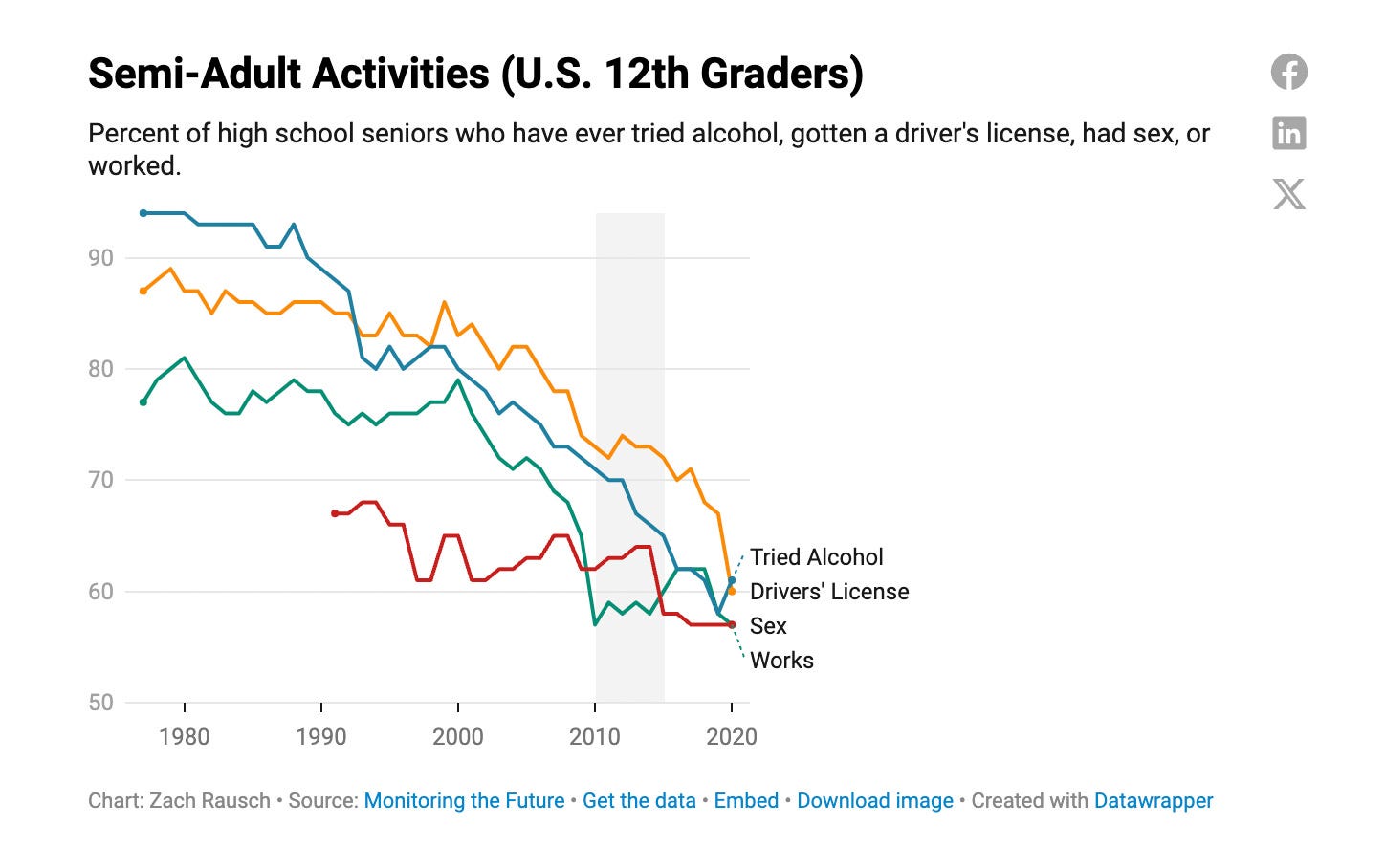TL;DR
Restaurants employ the more 16-24 year olds than any other industry in America
The prevalence of anxiety and depression is sky-rocketing within this age group
Jonathan Haidt, in his new book The Anxious Generation, attributes this to a combination of:
The decline of play based childhoods
The rise of phone and screen based childhoods
The mental health issues in this age group will have meaningful impact on the already challenged restaurant labor market
How will restaurants need to adapt in this context?
Empathy for our team members
Service model adjustments
Changes to shift structures
Additional training for managers
A few quick statistics before we start. All of these can be found in the resources section of The Anxious Generation.
- Anxiety amongst US undergraduates has risen from 10% to 24% since 2008
- Depression amongst US undergraduates has doubled since 2008
- People between 15-24 years old spent 154 minutes per day in person with friends in 2004. In January 2020 (pre-pandemic) that number had dropped to 43 minutes.
- The number of 12th graders who have a drivers license, have tried alcohol, had sex, or had a job have all dropped consistently since 1980.
Ok- having delivered those uplifting stats, on with the show!
Jonathan Haidt’s new book, The Anxious Generation is scary. The book attempts to explain the radical decline in adolescent mental health beginning around 2010. Haidt attributes the decline to a decrease in play-based childhood beginning in the 1980s. This was turbo-charged by the transition to smartphone-based childhood beginning in 2010. Haidt summarizes:
“...we ended up overprotecting children in the real world while underprotecting them in the virtual world.
As a father, I am terrified of this mental health pandemic but cautiously optimistic that, through work like Haidt’s, society (and our family) will counter the root causes before my daughter is heavily impacted. She is 2 ½ years old.
As a restaurant owner, the reality of this pandemic is here, now. As we’ve previously discussed, restaurants employ a lot of young people. Specifically, restaurants employ nearly 3x as many people under 24 as the rest of the economy. Anecdotally, 75% of our 120+ employees are under 30 years old across 3 restaurants.
There have been two prevailing themes around restaurant work in the post-Covid era. The first is that people do not view work like they used to, especially in on-site work like restaurants. A recent Wall St. Journal article references a Pew study from 2017 where 24% of respondents to a survey said their job or occupation was very important to their identity. In 2021, just 17% did. The article also points to hourly and salary wage increases in leisure and hospitality outpacing other jobs, chalking it up to an ‘in-person’ premium.
The second theme is that younger people, in particular, are more inclined to take personal days, vacation days, sick days, mental health days, or call out for things like excessive homework or exhaustion. In general, I think most restaurateurs would agree with the statement that their younger workforce is less reliable than in pre-pandemic times.
Covid forced young people to further isolate themselves with screens, but that began long before March of 2020. Post-covid also coincides with nearly 20 million Gen Z entering the workforce for the first time. And nearly 1 in 5 Gen Z who began working, did so in a restaurant. The restaurant industry will be ground zero for how a generation raised on phones, social media and significantly less in-person interaction will enter their professional lives.
It’s ironic that an industry predicated on in-person, human connection will be the first work experience for so many younger people. Excessive screen time can often exacerbate social awkwardness which then leads to avoidance of in-person interaction which worsens social awkwardness and the problem continues to spiral. I have always coached our teams that hospitality is a courageous act, that walking up to a complete group of strangers with the express intent of making them happier, requires bravery. This is especially true for the current younger generation of restaurant workers.
So how should we handle this as operators? Like many things in hospitality, the answer probably starts with empathy. As a 45 year old male, I cannot really understand what it would be like to be a teenage girl watching the world on Instagram or TikTok. That said, I remember what it was like to feel left out of something as a teen. What I can’t imagine, is what it would feel like to see in real time as others post their experience of things I was left out of. I’d have been crushed. I also remember the self-consciousness of comparing myself to others as a teenager. My ‘others’ were a few other people in my classes, not the entirety of social media posting an idealized version of themselves. How could this not be hugely impactful on a still-forming brain and identity?
But somehow the empathy has to balance with the reality of physical presence in restaurant work. I do not claim to have the answer to this but know that we’re addressing it in part with simplified service models, tableside access to information, and leaning into more information readily available to guests. We also find that shorter shifts are often more attractive to younger workers. Our inclination has always been to anchor in 7-8 hour days but are finding that 4-6 hour shifts work better for many roles. Being on, engaged in in-person interaction, for longer periods may be even more challenging for some. As an introvert, I can relate there too. We’re also investing more in managerial training in the hopes that our leaders feel better equipped to address the challenges they face. Some interesting new service businesses like Tableside and Hopdov, both started by former restaurant leaders, have been helpful on these fronts.
Haidt is very prescriptive about what to do going forward to stem the decline in mental health, all of which make a lot of sense.
Give children far more time playing with other children.
Look for more ways to embed children in stable real-world communities.
Don’t give a smartphone as the first phone.
Don’t give a smartphone until high school.
Delay the opening of accounts on nearly all social media platforms until the beginning of high school (at least).
He has much less to say about what to do in the here and now, and almost nothing to say about how employers should respond. The nature of restaurant work lends itself to a younger workforce so we’re going to have to navigate this. To finish on an optimistic note, I’d like to think that the opportunities for in-person connection and the camaraderie of restaurant work might also be beneficial in pushing back against the impacts Haidt has presented.







